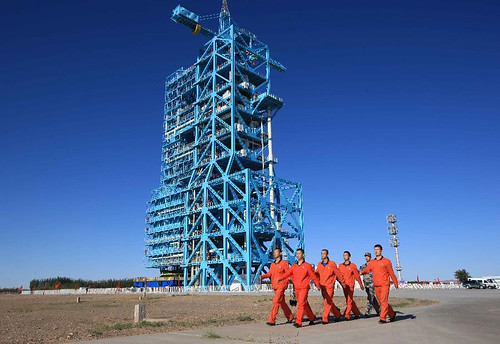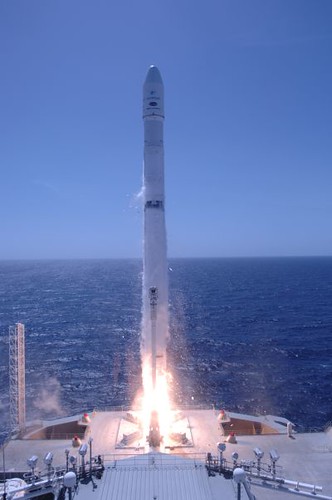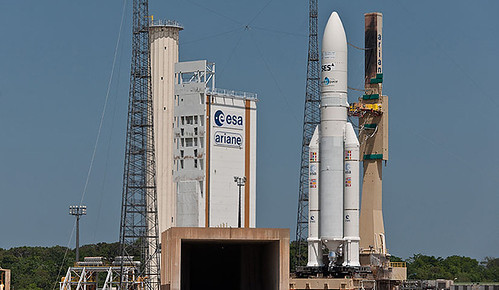WBMSAT Satellite Industry News Bits 09/30/2011
Friday, September 30th, 2011
Will you be at SatCon NY? Email me if you’d like to meet there.
Attend Satellite Interference Forum the day before SatCon Expo – see details.
National Reconnaissance Office declassifies two of America’s top satellite reconnaissance programs, GAMBIT (KH-7) and HEXAGON (KH-9) 25 years after top secret Cold War-era missions ended.
[SatNews – 09/30/2011]
ILS Proton Breeze M booster lifts off from Baikonur with SES satellite QuetzSat-1.
[SatNews – 09/29/2011]
China launches experimental module to lay groundwork for future space station.
[R&D Magazine – 09/29/2011]
Hosted Payload Alliance meeting October 13 at SATCON 2011 expected to be attended by more than 150 representatives from industry and government, following panel session “Hosted Payloads on the Horizon: Opportunities and Challenges.”
[SatNews – 09/29/2011]
Arianespace gets contract to launch Mexsat 3 for Mexico in 2012.
[SatNews – 09/29/2011]
Eutelsat subsidiary Skylogic signs with VIVACOM to provide new generation Tooway satellite broadband service in Bulgaria.
[Sacramento Bee – 09/29/2011]
CCID Consulting launches China’s Satellite Application Industry Map White Paper in Beijing, demonstrating industry layout and future trends.
[Market Watch – 09/29/2011]
European Space Agency provides research and development guidance to Finnish company Patria, with help of Tampere University of Technology, in designing search and rescue antenna that can be sewn into life vest.
[SatNews – 09/29/2011]
Globecomm Systems gets multiple contracts valued at approximately $4M to provide U.S. Government end-users with Ku- and X-band aeronautical services, following launch of Airborne managed network services offering.
[SatNews – 09/29/2011]
TCS gets another SNAP order from U.S. Army worth $15M.
[Market Watch – 09/29/2011]
New Guardian Mobility system brings real-time two-way text messaging to the arena of portable satellite Automated Flight Following systems.
[SF Gate – 09-29-2011]
Comtech Telecommunications says it will continue to grow in spite of the loss of two Army contracts, Blue Force Tracking and Movement Tracking System.
[Space News – 09/29/2011]

Stratos provides Inmarsat BGAN broadband satellite service enabling Hotmix Radio to stream live, mobile show from Paris Techno Parade on Sept. 17th.
[Market Watch – 09/29/2011]
TC Communications provides Inmarsat IsatPhone Pro tor Himalayan expedition led by Peter Hillary, son of legendary mountaineer Sir Edmund Hillary.
[SatNews – 09/29/2011]
Comtech EF Data and Intellian announce successful technology integration of v-Series antennas and ROSS Open Antenna Management protocol allowing maritime vessels to globally roam across multiple satellite beams.
[SatNews – 09/29/2011]
First high resolution satellite imagery released from NigeriaSat-2, revealing stunning 2.5m resolution photographs.
[SatNews – 09/28/2011]
Stratos introduces new FBB Flat Fee service plans for Inmarsat FleetBroadband.
[Market Watch – 09/28/2011]
EADS Astrium acquisition of Vizada prepares fighting lines for next MSS battleground.
[NSR – 09/28/2011]
Minotaur Rocket launches from Alaska with Navy TacSat4 satellite designed to allow troops with UHF radios to communicate without the need to deploy satellite antennas in dangerous situations.
[Fox News – 09/27/25011]
U.S. Space completes study for USAF and identifies cost-effective ways to procure military satellite communications.
[Market Watch – 09/27/2011]
Satellite Interference Reduction Group announces huge leap forward in fight against satellite interference following number of developments at IBC including introduction of video carrier ID across the industry.
[SatNews – 09/27/2011]
Thrane & Thrane signs to be key launch manufacturer for Inmarsat’s forthcoming Global Xpress service, a new Ka-band satellite Internet service expected to go live in 2013.
[SatNews – 09/27/2011]
Zenit 3-SL rocket launches from Sea Launch AG’s floating pad in equatorial Pacific with Eutelsat’s Atlantic Bird 7 satellite, marking first Sea Launch mission since emergence from bankruptcy.
[ninemsn – 09/26/2011]
NASA plans high-speed laser-based optical space communications system capable of moving data up to 100 times faster than current systems.
[Information Week – 09/26/2011]
Bentley Walker upgrades satellite Internet platform to iDirect’s iDX 3.0, and now provides faster satellite Internet across Europe, the Middle East, Africa, and South America.
[SatNews – 09/26/2011]
Ozonio and O3b Networks commit to providing Internet services to may remote towns and cities in Brazil’s State of Amazonas.
[Market Watch – 09/26/2011]
Adtec Digital’s EN-81 encoder/modulator and RD-60 decoder for 32APSK (Amplitude and Phase-Shift Keying) promise up to 30 percent more data using same bandwidth as 8PSK; companies testing include TV2Go of Canada, U.S. companies TNT and Encompass, and UK based IMG Media and British Sky Broadcaster.
[SatNews – 09/26/2011]
NASA reports that all debris from decommissioned research satellite appears to have fallen in remote section of Pacific Ocean.
[Wall Street Journal – 09/25/2011]
GOP presidential candidate Michelle Bachmann accuses administration of allowing LightSquared to “put millions of Americans in harm’s way” by allowing it to activate a wireless signal that interferes with GPS.
[CBS News – 09/23/2011]
Wireless Backhaul via Satellite, 5th Edition report, available from NSR.
[NSR – September 2011]









